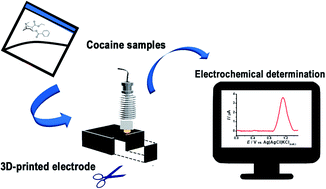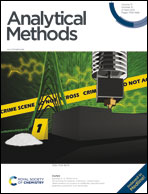3D-printing for forensic chemistry: voltammetric determination of cocaine on additively manufactured graphene–polylactic acid electrodes†
Abstract
Cocaine is probably one of the most trafficked illicit drugs in the world. For this reason, police forces require fast, selective, and sensitive methods for cocaine detection at crime scenes. Taking benefit of additive manufacturing, we demonstrate that 3D-printed graphene–polylactic acid (G–PLA) electrodes using the affordable fused deposition modelling technique can identify and quantify cocaine in seized drugs. The detection of cocaine based on its electrochemical oxidation on such electrodes was dramatically improved after an electrochemical surface treatment that generates reduced graphene oxide (anodic followed by a cathodic treatment). Square-wave voltammetric determination of cocaine was achieved in the concentration range between 20 and 100 μmol L−1, with a detection limit of 6 μmol L−1, and free from the interference of paracetamol, caffeine, phenacetin, lidocaine, benzocaine and levamisole, which are common adulterants found in seized drugs. The analytical characteristics obtained using 3D-printed G–PLA electrodes were comparable with those of previously reported electrochemical sensors, but presented the inherent advantages of the 3D-printing technology that enables low-cost, reproducible, and large-scale production of such electrodes in remote areas combined with the use of an environmentally-friendly biopolymer.

- This article is part of the themed collection: ENQA - 20th Brazilian Meeting on Analytical Chemistry


 Please wait while we load your content...
Please wait while we load your content...